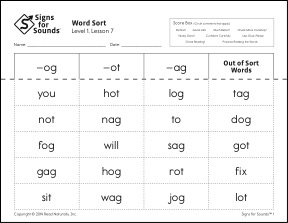A good educator finds strategies and programs that work and implements them in the classroom. A great educator begins with an effective strategy or program and then develops ways to extend the learning even further. Kristin McDaniel, a first-grade teacher in San Juan Capistrano, CA, is one of the great ones. Pleased with the results she was seeing from Read Naturally’s spelling program, Signs for Sounds, Kristin asked herself how she could capitalize on her students’ momentum. Was there a way to reinforce and solidify their understanding of the word patterns and high-frequency words featured in the program?
“I wanted my students to better understand the patterns the sound-out words share, and I wanted them to recognize the difference between these sound-out words and the spell-out (irregular high-frequency) words,” Kristin said.
So, Kristin took the words from each lesson in Signs for Sounds and created word sorts—activities that require students to group words by patterns. Students used “line-leader patterns” to create lists of words with shared patterns. “Students also separated the spell-out words and/or words that did not match one of the line leader patterns into their own column (Out-of-Sort Words), since there is no shared rule or pattern in these words,” Kristin explained.
Students did their word sort work independently after completing a Signs for Sounds lesson. With Kristin’s guidance, the Kindergarten, first-grade, and second-grade teams at her school now use Signs for Sounds along with the word sorts. “All three teams report improvements in word recognition and decoding in guided reading and improvements in spelling while writing,” Kristin said.
Inspired by Kristin’s story, we wanted to make printable word sorts easily available to all of our customers who are using Signs for Sounds 1. The Signs for Sounds Level 1 Word Sorts and the Signs for Sounds Level 2 Word Sorts are available as free downloads on the Read Naturally website.
Students can work on the word sorts as independent work after completing lessons, as Kristin’s class does, or the teacher can direct the word sort activity during small group instruction. Teachers can consider several options when assigning the word sorts:
1) After the student cuts the words apart and sorts the words below the line-leader patterns in the header, the teacher (or another adult) can check the student’s work. Then the words can be gathered into a plastic zip bag or envelope and used again to sort and review the words the next day.
2) The student can be directed to cut the words apart, sort the words, and then glue the header and each word in the correct column on a second piece of paper. This allows the teacher to check the student’s work at a later time.
3) When checking a student’s work, the teacher can extend this independent work a step further. By directing a student to read the words down each column and across each row, the teacher can confirm that the student is able to read each word within the pattern (reading down), mix the patterns (reading across), and read the “Out-of-Sort Words.”
Here is an example of a Word Sort. Students cut along the dotted lines and then sort the words into their correct column based on the pattern in the header.

Example of a Reproducible Word Sort from Signs for Sounds Level 1 (Lesson 7)
We love when educators like Kristin extend their students’ learning using Read Naturally materials. Thank you, Kristin, for sharing your story and making your word sorts for Signs for Sounds available for other teachers!

 Share your student’s success story—nominate him or her for our Star of the Month award. Win a Barnes & Noble gift card for the student and a Read Naturally gift certificate for your class!
Share your student’s success story—nominate him or her for our Star of the Month award. Win a Barnes & Noble gift card for the student and a Read Naturally gift certificate for your class!
Do you have levels 3 or 4?